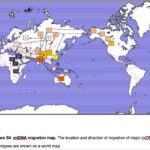
World Science en Route from Out-of-Africa to Out-of-America: First Stop is Out-of-Asia
bioRxiv doi: https://doi.org/10.1101/101410 Yuan, Dejian, Xiaoyun Lei, Yuanyuan Gui, Zuobin Zhu, Dapeng Wang, Jun Yu, and Shi Huang Modern Human Origins: Multiregional Evolution of Autosomes and East Asia Origin of Y and mtDNA Recent studies have established that genetic diversities are mostly maintained…
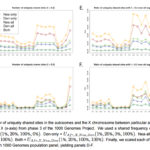
Peruvian Amerindians Have Strongest Genetic Ties to Archaic Hominins
Molecular Biology and Evolution (advance publication, October 18, 2016) Signatures of archaic adaptive introgression in present-day human populations Racimo, Fernando, Davide Marnettob, and Emilia Huerta-Sánchez Comparisons of DNA from archaic and modern humans show that these groups interbred, and in…
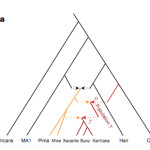
Amerindians Are Even More Genetically Diverse and Older Than You Thought
Science DOI: 10.1126/science.aab3884 Genomic evidence for the Pleistocene and recent population history of Native Americans Raghavan, Maanasa, Matthias Steinrücken, Kelley Harris, Stephan Schiffels, Simon Rasmussen, Michael DeGiorgio, Anders Albrechtsen, …Eske Willerslev. How and when the Americas were populated remains contentious….
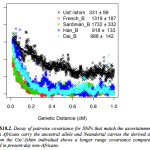
Ancient Ust’-Ishim DNA as Seen From the Americas
Nature 514, 445–449 (23 October 2014) doi:10.1038/nature13810 Genome sequence of a 45,000-year-old modern human from western Siberia Qiaomei Fu, Heng Li, Priya Moorjani, Flora Jay, Sergey M. Slepchenko, Aleksei A. Bondarev, Philip L. F. Johnson, Ayinuer Aximu-Petri, Kay Prufer, Cesare de Filippo,…
Web Gems, November 22, 2013
I’ve been monitoring global web responses to Raghavan et al.’s “Upper Palaeolithic Siberian Genome Reveals Dual Ancestry of Native Americans” that appear in the comments sections on Dienekes, Gene Expression and Eurogenes sites. The Web Gem Reward of this week goes…
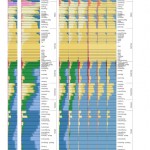
Ancient DNA from Mal’ta and Afontova Gora: A Full Account
Courtesy Alexander Kim, the long-awaited paper by the Eske Willerslev team became finally available to me. This is obviously not the last word on the subject of Amerindian origins, and the David Reich Lab has a different interpretation of ancient…
The End of Out-of-Africa: A Copernican Reassessment of the Patterns of Genetic Variation in the Old World
Over at Anthrogenica, I’ve been having some heated (as always) but this time also productive discussions regarding the interpretation of currently available genetic evidence. In the following I will sketch out a hypothesis that increasingly makes sense to me. 1….
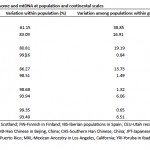
Molecular Variance Across Genetic Systems in Modern Humans and Their Kinship Structures
Gisele Horvat has kindly pointed me to this new pre-print. This post is cross-posted at www.kinshipstudies.org. Global patterns of sex-biased migrations in humans Chuan-Chao Wang, Li Jin, Hui Li. Abstract A series of studies have revealed the among-population components of…
How Many Germans Does It Take to Classify Amerindian Languages?
In his recent presentation on correlations between genes and myths in Eurasia and North America (see video in Russian, from 53:50 on), Vladimir Napol’skikh expressed a strong opinion on Amerindian linguistic diversity and several proposals of genealogical kinship between Amerindian…
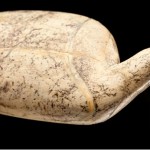
Genes and Myths: Ancient Mal’ta DNA and the Earth-Diver Mythological Motif
Earth-Diver is one of the most widely-distributed and well-studied cosmological myths. Found in mostly Uralic-speaking Eastern Europe, in Siberia, in Munda-speaking Northeast India and North America, its action is set in post-diluvial times when a demiurge sends various creatures to…
Ancient Mal’ta and Afontova Gora DNA Again
Now that Michael Balter’s news piece is out, I can retrieve my original post written in the wake of Eske Willerslev’s presentation at the Paleoamerican Odyssey conference in Santa Fe. Eske Willerslev‘s paper was on ancient DNA from the Mal’ta and Afontova…

An Out-of-America Signal as Seen Through Human Regulatory Genes
PLoS Genet 9(4): e1003404. doi:10.1371/journal.pgen.1003404 Balancing Selection on a Regulatory Region Exhibiting Ancient Variation That Predates Human–Neandertal Divergence Omer Gokcumen, Qihui Zhu, Lubbertus C. F. Mulder, Rebecca C. Iskow, Christian Austermann, Christopher D. Scharer, Towfique Raj, Jeremy M. Boss, Shamil…
Congenital Anomalies, Kinship Systems and Pleistocene Demography
PLoS ONE 8(3): e59587. doi:10.1371/journal.pone.0059587 An Enlarged Parietal Foramen in the Late Archaic Xujiayao 11 Neurocranium from Northern China, and Rare Anomalies among Pleistocene Homo Xiu-Jie Wu,Song Xing, and Erik Trinkaus. We report here a neurocranial abnormality previously undescribed in…
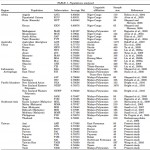
Is Taiwan to Austronesians what America is to Modern Humans?
American Journal of Physical Anthropology 150 (4): 551–564, April 2013 Ascertaining the Role of Taiwan as a Source for the Austronesian Expansion Sheyla Mirabal, Alicia M. Cadenas, Ralph Garcia-Bertrand, and Rene J. Herrera. Taiwanese aborigines have been deemed the ancestors…
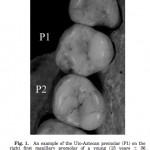
The Uto-Aztecan Premolar and a Back-Migration of American Indians to the Old World
American Journal of Physical Anthropology 143 (4): 570-578, 2010 DOI: 10.1002/ajpa.21351 The Uto-Aztecan Premolar Among North and South Amerindians: Geographic Variation and Genetics Miguel E. Delgado-Burbano, G. Richard Scott, and Christy G. Turner II The Uto-Aztecan premolar (UAP) is a dental…
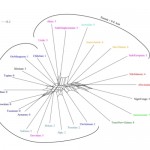
Stability vs. Diversity: A Novel Method for Analyzing Worldwide Linguistic Structures
PLoS ONE 7(9), 2012: e45198. doi:10.1371/journal.pone.0045198 Abstract Profiles of Structural Stability Point to Universal Tendencies, Family-Specific Factors, and Ancient Connections between Languages Dan Dediu, and Stephen C. Levinson Language is the best example of a cultural evolutionary system, able to…
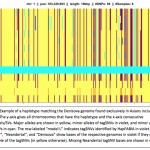
Rare Haplotypes in Koreans: Evidence for a Back Migration into Africa?
CAMDA 2012 Conference, July 13, 2012 Rare Haplotypes in the Korean Population Sepp Hochreiter, Gunter Klambauer, Gundula Povysil, and Djork‐Arné Clevert Link (Full Text PDF) These days you never know where research related to modern human origins will be reported…
Novel mtDNA and Y-DNA Haplogroups and Polymorphisms in South American Indians
DNA in Forensics 2012, Sep 06-08 2012 Below are some of the more interesting findings related to New World genetics reported at the recent “DNA in Forensics 2012” conference held at the University of Innsbruck, Austria (via Dienekes). The detection…
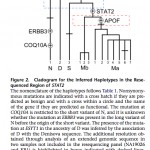
Archaic Introgression and the Derived Nature of African Lineages at STAT2 Gene
American Journal of Human Genetics 91, 2012, 265-274. http://dx.doi.org/10.1016/j.ajhg.2012.06.015. A Haplotype at STAT2 Introgressed from Neanderthals and Serves as a Candidate of Positive Selection in Papua New Guinea Fernando L. Mendez, Joseph C. Watkins, and Michael F. Hammer. Signals of…
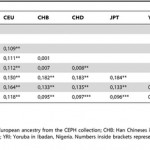
The Xavante Indians and Genetic Divergence Between American Indians and Africans
PLoS ONE 7 (8): e42702. doi:10.1371/journal.pone.0042702 Genome-Wide Analysis in Brazilian Xavante Indians Reveals Low Degree of Admixture Patricia C. Kuhn, Andréa R. V. Russo. Horimoto, José Maurício Sanches, João Paulo B. Vieira Filho, Luciana Franco, Amaury Dal Fabbro, Laercio Joel…
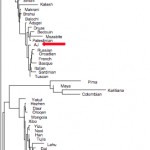
How to Interpret Patterns of Genetic Variation? Admixture, Divergence, Inbreeding, Cousin Marriage
Two different but important population genetics papers have come out. One is Steven Bray et al. (2010) “Signatures of Founder Effects, Admixture, and Selection in the Ashkenazi Jewish Population.” The other one is Isabel Alves et al. (2012) “Genomic Data…
Identity Politics in the Name of Science: The Battle over American Indian Blood and Bones Continues
As we learned in my previous post, Reich et al. (2012, 4) claim to have conducted the “most comprehensive survey of genetic diversity in Native Americans so far.” I noticed that their study admitted a few ironies and misapprehensions, but…
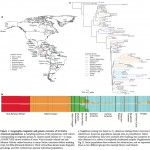
A Three-Wave Model for the Peopling of the Americas, or a Three-Wave Back-Migration from the Americas to the Old World
Nature (2012) doi:10.1038/nature11258 Reconstructing Native American population history Reich, David, et al. The peopling of the Americas has been the subject of extensive genetic, archaeological and linguistic research; however, central questions remain unresolved. One contentious issue is whether the settlement occurred…
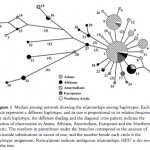
Molecular Variability of the 16p13.3 Region in American Indians
Annals of Human Genetics (2007) 71, 64–76 DOI: 10.1111/j.1469-1809.2006.00296.x Molecular Variability of the 16p13.3 Region in Amerindians and Its Anthropological Significance Battilana, J., L. Cardoso-Silva, R. Barrantes, K. Hill, A. M. Hurtado, F. M. Salzano and S. L. Bonatto A…
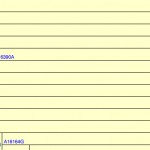
More on Amerindian mtDNA haplogroups X2, B2 and C4: Evidence from Siberian Tubalars, Tuvans, Evens and Ulchi
American Journal of Physical Anthropology Vol 148, No. 1, pages 123-138, May 2012 DOI: 10.1002/ajpa.22050 Mitochondrial Genome Diversity in the Tubalar, Even and Ulchi: Contribution to Prehistory of Native Siberians and Their Affinities to Native Americans Sukernik, Rem I., Natalia V….
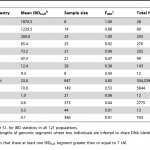
The Effect of Long-Term Endogamy on Identity-By-Descent
PLoS ONE 7(4): e34267. doi:10.1371/journal.pone.0034267 Cryptic Distant Relatives Are Common in Both Isolated and Cosmopolitan Genetic Samples Henn, Brenna M., Lawrence Hon, J. Michael Macpherson, Nick Eriksson, Serge Saxonov, Itsik Pe’er, Joanna L. Mountain. Although a few hundred single nucleotide…
Piraha Indians, Recursion, Phonemic Inventory Size and the Evolutionary Significance of Simplicity
Daniel Everett has a new book out that will surely stir more controversy around Piraha Indians, Chomskyan recursion and the evolution of human language. I haven’t read this book yet, but The Chronicle of Higher Education has an extensive coverage…
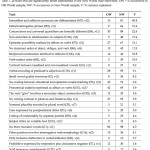
American Indian Uniqueness: Linguistics and Genetics
Journal of Linguistic Relationship 5 (2011): 130-134. Similarities among Languages of the Americas: An Exploration of the WALS Evidence Wichmann, Søren, Eric W. Holman, Dietrich Stauffer, and Cecil H. Brown. Abstract. An exploration of WALS (i.e. the World Atlas of…
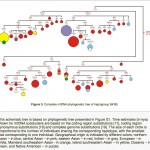
The Origin of mtDNA haplogroup B: 9-bp deletion in America, Asia and Africa
PLoS ONE 7(2) 2012: e32179. doi:10.1371/journal.pone.0032179 Complete Mitochondrial DNA Analysis of Eastern Eurasian Haplogroups Rarely Found in Populations of Northern Asia and Eastern Europe Derenko M., Malyarchuk B., Denisova G., Perkova M., Rogalla U., et al. Abstract. With the aim…
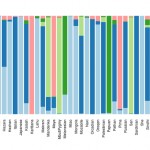
American Indians, Neanderthals and Denisovans: PCA and ADMIXTURE
Dienekes continued his search for “archaic admixture” in world populations. This time he blended ADMIXTURE and PCA approaches to plot 5 composite populations detected by ADMIXTURE in the Harvard HGDP set. American Indians are back in. The ADMIXTURE plot replicates…
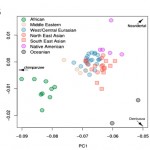
American Indians, Neanderthals and Denisovans: Insights from PCA Views
Dienekes posted a SNP PCA showing the relative position of a sample of modern human populations from the Harvard HGDP along the axes formed by Chimpanzees, Denisovans and Neanderthals. On the broad-view PCA, the red dot indicates Chimpanzees, the green…
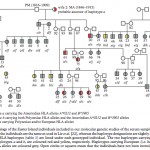
American Indian HLA Genes on Easter Island
Phil. Trans. R. Soc. B 19 March 2012 vol. 367 no. 1590 812-819 doi: 10.1098/rstb.2011.0319 The Polynesian Gene Pool: An Early Contribution by Amerindians to Easter Island Erik Thorsby Abstract. It is now generally accepted that Polynesia was first settled by…
Archaic Morphology and American Indian Biological Variability
On the heels of my last post about the possibly systematic trend to ignore American Indian samples in the studies of worldwide variation, there’s a new paper dealing with the discovery of human remains with archaic morphology as late as…
Are American Indian Populations Subject to Sampling Bias in Human Origins Research?
The latest post by Dienekes re-kindled an observation that I wanted to make for a long time. Dienekes applied TreeMix software to ADMIXTURE components derived from HapMap-3 populations and created a tree with Sub-Saharan, East African, Northwest African, Gedrosia, Southwest…
Admixture: An Amerindian Component in Eurasian Populations
About a year ago, one of genome bloggers, Diogenes, discovered, using ADMIXTURE, an intriguing “Amerindian” component in a wide range of East and West Eurasian populations. Here are the results of his ADMIXTURE runs. Grey represents the component that’s modal…
Solutrean and Clovis
John Hawks complains about the hype around the book by Dennis Stanford and Bruce Bradley’s long-awaited book Across Atlantic Ice: The Origin of America’s Clovis Culture. Posing as an honest academic only interested in facts and not hype, Hawks writes…
Neanderthals and Amerindians: Intragroup Genetic Diversity and Population Size
John Hawks writes: “Neandertals have strikingly limited genetic variation. They once lived across a range from Spain to Siberia. Yet when we compare sequences across their whole genomes, we find them to be much less different across this geographic range…
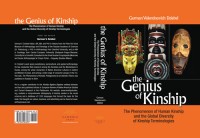
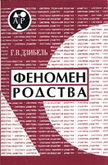
Recent Comments